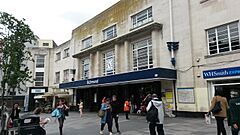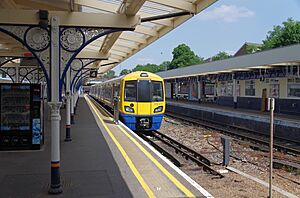Richmond station (London) facts for kids

Kew Road entrance as seen in June 2016
|
|
| Location | Richmond |
|---|---|
| Local authority | London Borough of Richmond upon Thames |
| Managed by | South Western Railway |
| Owner | Network Rail |
| Station code | RMD |
| DfT category | B |
| Number of platforms | 7 |
| Accessible | Yes |
| Fare zone | 4 |
| Key dates | |
| 27 July 1846 | Opened as Terminus (R&WER) |
| 1848 | Station moved (WS&SWR) |
| 1 January 1869 | Opened (L&SWR via Hammersmith) |
| 1 January 1869 | Started (NLR) |
| 1870 | Started and Ended (GWR) |
| 1 June 1877 | Started (DR) |
| 1 October 1877 | Started (MR) |
| 1 January 1894 | Started (GWR) |
| 31 December 1906 | Ended (MR) |
| 31 December 1910 | Ended (GWR) |
| 3 June 1916 | Ended (L&SWR via Hammersmith) |
| 1 August 1937 | Stations merged (SR) |
| Other information | |
| Lists of stations | |
| Other websites |
|
Richmond Station, also known as Richmond (London), is a busy train station in Richmond, Greater London. It's on the Waterloo to Reading and North London train lines.
Trains run by South Western Railway use this station. It's located between North Sheen and St Margarets stations. It's about 15.6 kilometers (9.7 miles) from London Waterloo. You can also catch London Overground and London Underground (District line) trains here. The next station for these services is Kew Gardens.
Contents
Station Design and Look
The station building was designed by James Robb Scott in 1937. It's made of Portland stone and has an Art Deco style. You can see a square clock on its front.
In 2013, the area in front of the main entrance became a pedestrian zone, meaning only people can walk there. It also has a war memorial for a soldier named Bernard Freyberg, who was born in Richmond.
A Look Back: Richmond Station's History
Early Days and First Stations
The first Richmond station opened on 27 July 1846. It was built by the Richmond and West End Railway (R&WER) as the end point of its line from Clapham Junction. This first station was located where a multi-storey car park is now.
Later, the Windsor, Staines and South Western Railway (WS&SWR) extended the line further west. They moved the station to a new spot, slightly west of where the main tracks are today. Both the R&WER and WS&SWR were part of the London and South Western Railway (L&SWR).
New Lines and Connections
On 1 January 1869, the L&SWR opened a new line called the Kensington and Richmond line. This line connected to the West London Joint Railway and ran through places like Hammersmith (Grove Road) station (now closed) and Turnham Green.
Most of this line is now part of the London Underground District line. The line south from Gunnersbury was also used by the North London Railway (NLR) and is now used by London Overground.
Different Train Companies
For a short time in 1870, the Great Western Railway (GWR) ran trains from Paddington to Richmond. They used the Hammersmith & City Railway tracks.
On 1 June 1877, the District Railway (DR) connected its line from Hammersmith to the L&SWR tracks. This allowed DR trains to start running to Richmond. Later that year, on 1 October 1877, the Metropolitan Railway (MR) also started a service to Richmond.
The DR route from Richmond to central London was more direct than other routes. By 1894, the GWR also began sharing the MR's Richmond service. This meant that Gunnersbury was served by five different train companies!
Electric Trains Arrive
After 1903, the District Railway started using electric trains on some of its lines. They then paid to electrify the line from Gunnersbury to Richmond, which was finished on 1 August 1905. This meant the DR ran electric trains, while other companies like L&SWR and GWR still used steam trains.
Over time, some services stopped. The MR services ended in 1906, and GWR services ended in 1910. In 1916, the L&SWR also stopped its service to Hammersmith because of competition from the District line. This left the District line and the NLR as the main operators.
Station Rebuilding
In 1923, many railway companies merged. The L&SWR became part of the Southern Railway (SR), and the NLR became part of the London, Midland and Scottish Railway (LMS).
On 1 August 1937, the Southern Railway opened a rebuilt Richmond station. The station building and the main through platforms were moved to be next to the terminal platforms. Around the same time, the goods yard (where freight was handled) was also moved to a new location.
Station Incident
On 18 September 1987, a District line train arriving at Richmond hit the end of platform 6. It broke some glass panels behind the buffers. Luckily, no passengers were seriously hurt.
Station Platforms
Richmond station has seven platforms, numbered from 1 to 7, starting from the south side.
- Platforms 1 and 2 are for South Western Railway trains that pass through the station.
- Platforms 3 to 7 are for trains that end their journey at Richmond. These are used by:
- London Overground North London line trains (usually platforms 3 and 4, but sometimes 5, 6, and 7).
- London Underground District line trains (usually platforms 5, 6, and 7. Sometimes platform 4, but never 3 because platform 3 doesn't have the special fourth rail needed for District Line electric power).
In 2011, work began to make platforms 1 and 2 longer. This was so they could fit trains with 10 carriages. Most of the lengthening happened at the west end of the platforms. The roofs over the platforms were also repaired as part of this work.
The wide space between platforms 3 and 4 used to have an extra track. This track was used for steam locomotives to change direction.
You can find eight shops and cafes at the station. These include four places to eat, two small kiosks, a florist, and a WH Smith shop. There's also an M&S Simply Food grocery store.
Train Services
Trains at Richmond station are run by South Western Railway, London Overground, and London Underground (District line).
Here's how often trains usually run during off-peak times:
- South Western Railway:
- 6 trains per hour (tph) to London Waterloo. Two of these stop only at Clapham Junction, two are semi-fast, and two stop at all stations via Barnes.
- 2 tph to Teddington, which then return to London Waterloo via Kingston and Wimbledon.
- 2 tph to Reading via Bracknell.
- 2 tph to Windsor & Eton Riverside.
- London Overground:
- 4 tph to Stratford via Willesden Junction.
- London Underground (District Line):
- 6 tph to Upminster via Tower Hill.
During busy peak hours, there are extra trains. These include services to and from Shepperton, Camberley, Aldershot, and London Waterloo via Hounslow.
| Preceding station | Following station | |||
|---|---|---|---|---|
| Putney or Clapham Junction |
South Western Railway Waterloo to Reading Line
|
Twickenham | ||
| North Sheen | South Western Railway Kingston Loop Line
|
St Margarets | ||
| Preceding station | Following station | |||
| Terminus | North London Line | Kew Gardens towards Stratford
|
||
| Preceding station | Following station | |||
| Terminus | District line | Kew Gardens towards Upminster
|
||
| Abandoned Plans | ||||
| Preceding station | Following station | |||
| Terminus | Central line | Kew Gardens towards Liverpool Street
|
||
Bus Connections
Many London Buses routes stop at Richmond station. These include routes 33, 65, 110, 190, 337, 371, 419, 490, 493, H37, R68, R70, and mobility route 969. There are also night bus routes N22 and N65.


